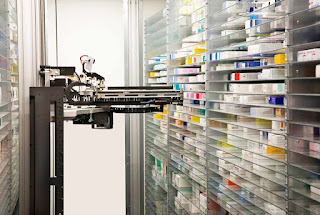- Get link
- X
- Other Apps
- Get link
- X
- Other Apps
 |
| Central Fill Pharmacy Automation |
How Central Fill Automation Works
At a Central Fill Pharmacy Automation, prescriptions that are sent electronically from different retail locations are automatically routed to the centralized dispensing facility. There, automated robots and machinery take over to fulfill orders with minimal human involvement. Robotic arms retrieval medications from the drug stock shelves based on the prescription data. Any necessary counting, pouring, and labelling is done by machines with precision.Once fully assembled, the medication packages are verified against the prescription for accuracy by a technician monitoring the system. Correct prescriptions are then automatically packaged and labelled for delivery back to the originating pharmacy counter. Misfilled prescriptions are removed from the automated process for human rework to ensure patient safety. The entire central fill operation is digitally tracked and documented for auditing purposes.
Benefits of a Central Fill Model
Centralizing prescription filling offers pharmacies several advantages over a traditional decentralized workflow:Increased throughput - Automated machinery allows a central fill facility to fulfill a much higher volume of prescriptions per day compared to manual filling done at individual pharmacy counters. This scaling helps accommodate pharmacy growth.
Higher accuracy - Robotic technology and automated verification stages minimize human error in medication selection, counting, and labelling. Central fill can achieve 99% or higher accuracy rates.
Consistency - The centralized model ensures uniform prescription preparation using calibrated automation across all participating pharmacy locations. Patient safety is less dependent on individual technician skills.
Labor Savings - Fewer technicians are needed at the centralized site compared to staffing each individual pharmacy counter. Labor costs per prescription are significantly reduced.
Economies of Scale - The high fixed costs of robotic automation equipment are spread out among all prescriptions filled through the central facility rather than a single retail pharmacy.
Challenges in Implementing Central Fill Systems
While central fill offers compelling advantages, pharmacies must overcome some challenges to successfully transition to this model:Upfront Capital - Establishing an automated
central fill facility requires a substantial upfront capital investment in
robotic equipment, software, customized workflow design, and facility modification
or construction.
Change Management - Shifting from a
decentralized to centralized prescription filling model is a significant
workflow change that requires technology adoption and retraining pharmacy
staff. Strong change management is critical.
Integration Complexity - Ensuring
seamless data exchange and prescription routing between differing pharmacy
management systems across locations adds IT complexity.
Delivery Logistics - An efficient
delivery network must be set up and coordinated to transport filled
prescriptions back out to individual pharmacies on time.
Regulatory Compliance - Central fill
operations must comply with state and federal regulations regarding
prescription filling standards, recordkeeping, and security.
To address these challenges, pharmacies work closely with central fill
automation vendors who provide turnkey solutions and services for technology
procurement, workflow design, staff training, and ongoing technical support.
Vendors help pharmacies streamline their central fill implementation process.
The Future of Central Fill Pharmacy Automation
As central fill technology continues evolving, pharmacies can expect even greater efficiency gains and cost savings through emerging enhancements:Artificial Intelligence (AI) - AI and machine learning will optimize robotic fulfillment based on prescription patterns to minimize wait times. Speech recognition allows voice-directed picking.
Automated Dispensing Cabinets (ADC) - Cabinet robots handle final packaging for immediate patient pick-up without human intervention. ADCs automate the retail counter workflow.
Internet of Things (IoT) - Connected devices ensure seamless tracking and real-time visibility of prescription status from central fill to retail pick-up through an IoT platform.
Mobile Technologies - Mobile apps facilitate
photo verification of filled prescriptions and curbside/home delivery to
improve patient access and convenience.
As a strategic long-term investment, central fill pharmacy automation
ultimately helps pharmacies transform themselves into more scalable, profitable
enterprises that can meet constantly growing medication needs in an era of
intensifying industry competition and cost pressures.
Get more
insights, On Central
Fill Pharmacy Automation
- Get link
- X
- Other Apps
Comments
Post a Comment